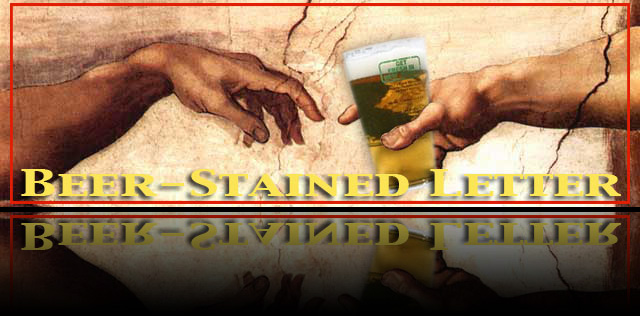Throwing your beer a curve, Part 1
 There’s something about beer in a glass.
There’s something about beer in a glass.
It’s inviting and relaxing, mesmerizing almost, as it settles beneath a foam crown, bubbles rising.
It’s a siren in the classical sense.
So when we heard Boston Beer Company (aka Samuel Adams) was shaking up the reliable pint glass, giving it the heave-ho in favor of a new 16-ounce model styled for its Boston Lager, we were suitably curious.
After all, the sturdy, simplistic shaker glass is practically the icon of poured beer. It blew the chunky, workhorse mug of our fathers’ generation off the bar years ago to become the alpha glass.
But this new Sam Adams glass … it has starlet curves. And we wondered if it would make the shaker pint a Sony Walkman in an iPod world.
For some answers, we turned to Boston Beer.
And happy to explain what was on their minds by commissioning the design, engineering and manufacture of the glass was brewing manager Grant Wood (a different Grant Wood, but an American artist in his own right, albeit in the media of malt and hops).
With a dozen years at Boston Beer, Grant has a hand in the 20-plus beers produced under the Samuel Adams brand. So he knows beer.
And if he’s not practicing what he preaches -- drinking what he’s brewing -- he may be inclined to sip a Belgian beer, a lambic perhaps. So he does peer through the bent-back tulips, so to speak, to see how the other half lives (if you don’t mind a Beatles metaphor).
That said, two of our key questions to Grant were:
Our old friend, Shaker Pint, you got a problem with it? (Pardon the phrasing, but this is New Jersey, you know.)
And …
If the new glass is good for a Boston Lager, what about a Princeton brewpub porter?
Second question first.
Grant says the new glass -- a fusion of the shaker pint and the tulip glass typically associated with some Belgian beers -- was indeed tailored for the Boston Lager, its malt profile and noble hops. Even among Samuel Adams’ stable of brews, the new glass is the province of the Boston Lager.
So, we surmise that for Garden State beers, we’re on our own, and our mileage is probably going to vary.
And to our other question, Grant says there’s no problem with the shaker pint. It has done quite a functional job at the bar. But …
“You can do better, and I think we proved that with this particular glass,” he says.
The devil is in the details. And that’s where the difference between curvy newbie and shaker pint comes in, Grant says. It’s the nuances of flavor and aromatics and how and when you encounter them. Smell then taste, sweet before bitter, and a dynamic in which that can continue over the life of a pint. (Smelling is a compass for the taste buds. The nose knows, and it delivers more than half of your flavor sensations.)
Some test tasting zeroed in on the shortcomings of other glassware.
The shaker pint wasn’t well suited for capturing aroma. “Especially when you get to the bottom of glass,” Grant says. Pilsner glasses and their tall V-shapes were worse, generating a lot of bubbles and allowing the beer to warm quickly. They were like chimneys “and aroma wafted away faster,” he says.
But the new glass -- Grant confesses he was an early skeptic -- and its somewhat double-goblet shape offered a different experience.
When you sip from it, he says, the rolled tulip lip fits to the mouth and puts the beer to the front of your tongue, so you taste maltiness, that sweet before hop bitter. (Reminder: He is referring to drinking a Sam Adams Boston Lager.) And, Grant says, he anticipated hop aroma, but the new glass also provided enhanced malt aroma. (Remember, the nose knows and the importance of that.)
The glass is also laser etched on the bottom, some engineering work that keeps feeding bubbles. The result is sustained beer aromas. (We’d like to reiterate that nose comment.)
It should be noted that Boston Beer wasn’t trying to reinvent the wheel, just create a glass for beer drinkers that brings out the best in its best-known brew, a “next step to bringing them to beer nirvana,” as Grant says.
He hopes the glass is something for other brewers to look at, perhaps consider, even if it’s just across beer culture.
So maybe it’s not autumn for the shaker glass after all, just a nice set of curves set on the bar that can make one beer better and beer in general more fun.
And for us …
Accepting what Grant and others at Boston Beer say about the new glass and the beer it was designed for (and we’ve enjoyed a Boston Lager from it), we’re still curious about how a Jersey ESB or IPA would fare within its contours.
Stay tuned. We’re going to find out.
NOTE: Boston Beer is providing the new glasses to its better draft beer accounts nationwide. So you could see it show up in the rotation at your favorite bar. It's also for sale in sets of four from Boston Beer (check their website), so you don't have to return to those days of slipping your server a sweeter tip so she'd look the other way as you swiped a glass. 














